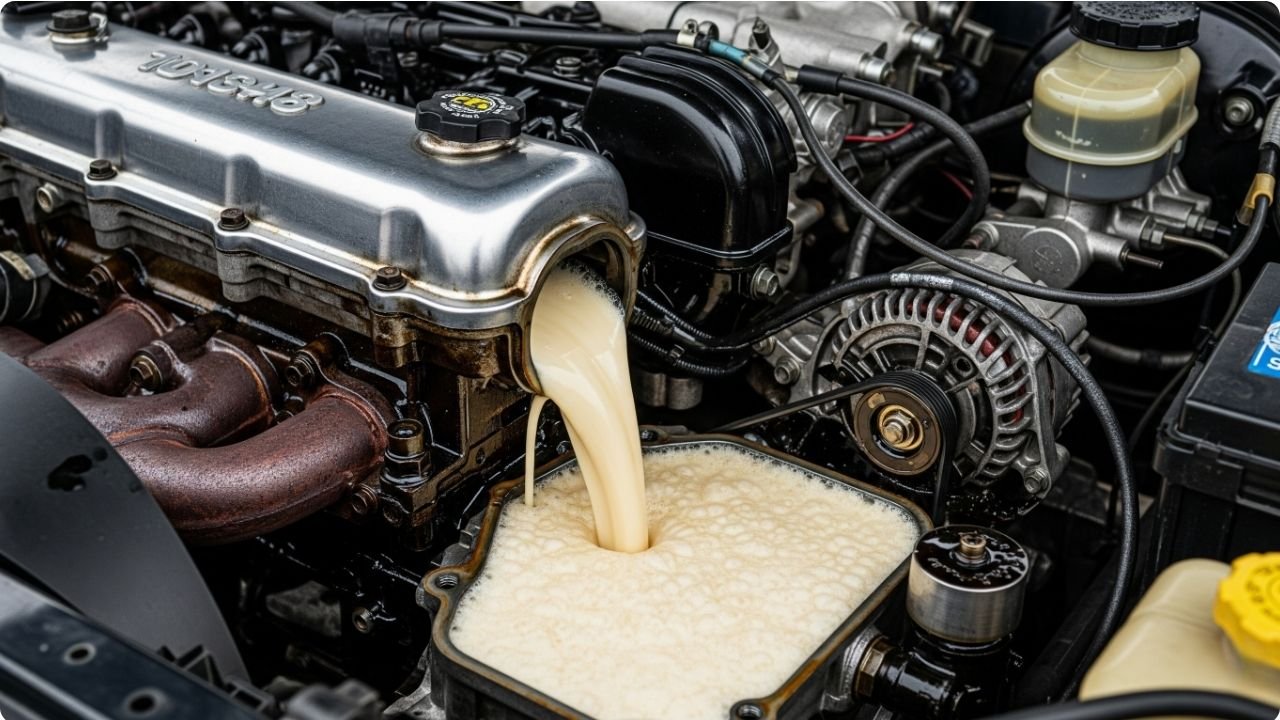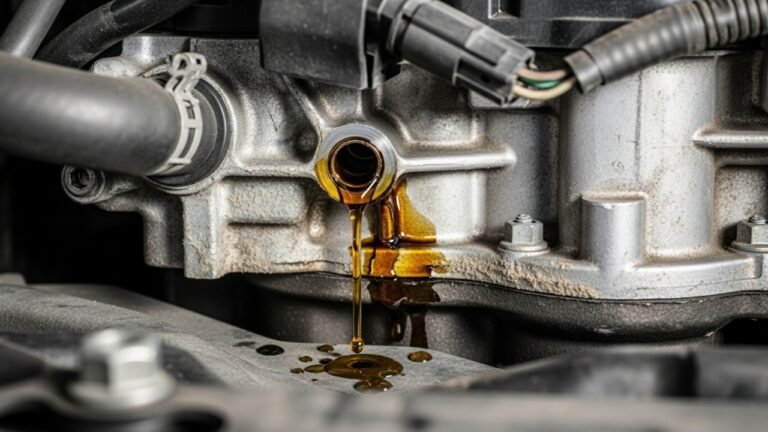Is It Bad to Have Too Much Oil in Your Car?

Let me tell you a little story. A few years back, I was prepping for a long road trip from Dhaka to Cox’s Bazar. I checked everything — tire pressure, wipers, lights, and of course, the engine oil. Thinking I was being extra careful, I poured in a bit more oil. “More oil must mean better protection, right?” I told myself. Spoiler alert: I was wrong.
That seemingly small mistake taught me something huge — too much oil in your car is just as bad as too little. Maybe worse. And trust me, this isn’t just about damaging a part or two. It’s about risking your whole engine.
In this article, I’ll share what I wish someone had told me — in simple words, with zero technical jargon. We’ll break down why overfilling your car oil is a bad idea, what it does to your engine, the symptoms, and how to fix it. And yep, we’ll keep it friendly and honest all the way through.
What Happens When You Put Too Much Oil in Your Car?
Think of your engine as a perfectly balanced recipe. Just like you wouldn’t pour five extra cups of water into a cake mix, you shouldn’t go wild with engine oil either. The system is built with exact measurements in mind.
When there’s too much oil in your car, it creates a thick, frothy mess inside the engine. That bubbly oil can’t do its job right. Instead of smoothly coating engine parts, it turns into foam — which means the engine isn’t being properly lubricated. Ironically, the very thing you added to “protect” the engine ends up hurting it.
Here’s what excess oil can lead to:
- Increased oil pressure, which can blow out seals and gaskets
- Crankshaft resistance, reducing engine efficiency
- Oil entering parts it shouldn’t, like the combustion chamber
- Spark plug contamination, causing misfires
In short? It’s like giving your engine a stomachache that could lead to full-on surgery.
How Much Oil is Too Much?
You might wonder: “But how much is too much?” Good question.
Most car engines only need 4 to 6 quarts of oil, depending on the make and model. Always refer to your owner’s manual. There’s usually a dipstick to check levels. If the oil is even half an inch above the “MAX” line, it could be too much.
Here’s a quick comparison in a table for visual clarity:
| Engine Size | Approximate Oil Capacity | Safe Overfill Margin |
|---|---|---|
| 4-cylinder engine | 4 – 4.5 quarts | None |
| 6-cylinder engine | 5 – 6 quarts | Max 0.2 quarts |
| 8-cylinder engine | 6 – 8 quarts | Max 0.3 quarts |
Even just 0.5 quarts too much can cause problems in smaller engines. Bigger engines may tolerate a tad more, but not much.
Why People Overfill Oil (And Why You Shouldn’t)
Overfilling usually happens by accident. We’ve all been there — in a rush, guessing instead of measuring, or topping off without checking the dipstick first.
Sometimes mechanics overfill oil too. Yep, even pros can mess up. It happens when they forget to check after a filter change or don’t drain old oil completely.
And here’s the myth that needs busting:
“More oil = more protection.”
That’s just not true. Engines are engineered with tight tolerances. Excess oil creates resistance, pressure, and leaks. It doesn’t “add” protection. Instead, it adds trouble.
Signs You Have Too Much Oil in Your Car
If you’ve recently changed or topped up oil and something feels off, pay attention. Your car is probably trying to tell you something.
Look out for these symptoms:
- White smoke from the exhaust
- Burning oil smell inside the cabin
- Rough idling or engine hesitation
- Oil leak under the car
- Check Engine light or Oil Pressure warning
- Poor fuel economy
- Misfiring or strange engine noises
Each of these is like a red flag waving in your face. If you notice more than one, don’t wait. You need to check the oil level immediately.
Risks of Driving with Too Much Oil
Let me be blunt: Driving with too much oil can destroy your engine. No sugarcoating it.
Here’s what could go wrong:
- Oil Foaming
When the crankshaft spins through excess oil, it creates foam. Foamy oil can’t lubricate. That leads to metal-on-metal friction — the ultimate killer. - Blown Seals & Gaskets
Excessive pressure pushes oil into places it shouldn’t go. You might end up with leaking head gaskets or busted seals. These repairs can cost thousands. - Catalytic Converter Damage
If oil burns inside the engine, it sends particles to your exhaust. That’s bad news for your catalytic converter, which can clog or break. - Spark Plug Contamination
If oil reaches the plugs, they can’t fire correctly. That causes misfires, shaking, poor performance, and a rough drive.
What Should You Do If You Overfill Your Oil?
First off — don’t panic. If you just overfilled a little and haven’t started the engine, it’s a simple fix.
Here’s what to do:
- Check the Dipstick
Look at how far the oil level is above the max line. - Use an Oil Extractor
These handy tools can pull oil through the dipstick tube. No need to go under the car. - Drain from the Plug
If you don’t have an extractor, carefully remove the drain plug and let a little oil out. Replace the plug tightly. - Recheck Levels
Let the engine sit for a few minutes. Recheck the dipstick. Top off only if needed. - Watch for Symptoms
Drive a short distance and monitor. If you smell burning oil or see smoke, stop immediately.
It’s always safer to underfill slightly than overfill. You can top up later — but fixing damage from overfilling? That’s a whole other story.
How to Prevent Overfilling Your Engine Oil
You know what they say — prevention is better than repair bills. Luckily, avoiding too much oil in your car is easy if you follow a few simple habits.
Here’s how to avoid this oily mess:
- Always use the dipstick – Before and after adding oil.
- Read your owner’s manual – Don’t guess how much oil your car needs.
- Pour slowly – Add a little at a time, especially when topping off.
- Let the car rest before checking – Oil takes a few minutes to settle. Check levels after the engine cools.
- Mark the bottle – If you’re adding from a large container, mark your pour line so you don’t overdo it.
- Use transparent measuring funnels – It’s easier to track how much you’re adding.
Treat your car like you would a pressure cooker. Too much oil? Boom — damage. Just enough? Perfectly balanced, like your mom’s biryani recipe.
Cultural Myths: More is Not Always Better
Let’s get real for a second. In many cultures — especially in South Asia — there’s this belief that “more is always better.” Whether it’s food, love, or engine oil, we often think piling on means extra care.
But when it comes to cars? This mindset can backfire. I’ve met many uncles at tea stalls in Mymensingh who proudly say, “Ekta bottle beshi diye disi, engine bhalo thakbe.” (Translation: “I added an extra bottle, it’ll keep the engine better.”)
The truth is — engines aren’t built for that kind of love. They need balance, not overflow. Respecting those limits is a form of care, too. It’s about precision, not abundance.
What Mechanics Don’t Always Tell You
Sometimes, you leave a garage thinking everything’s fine. But later you see smoke, or smell burning oil. What gives?
Some mechanics — especially when in a rush — might:
- Not completely drain the old oil
- Forget to reset the dipstick check
- Add oil without considering filter change volume
That’s why it’s important to double-check before leaving. Ask them to show you the dipstick reading. It’s your car, your money, and your future rides on the line.
Don’t feel shy to ask. You’re not being rude — you’re being smart.
Quick Reference Table: Symptoms vs. Action
Here’s a helpful table you can save or screenshot:
| Symptom | What It Means | What to Do |
|---|---|---|
| White smoke from exhaust | Oil in combustion chamber | Check oil level, extract excess |
| Oil smell in cabin | Oil leaking or burning | Stop car, inspect immediately |
| Rough idling/misfires | Spark plug contamination | Check plugs, drain extra oil |
| Oil leak under car | Blown seal due to pressure | Visit a mechanic |
| Check Engine light | Engine under stress | Use OBD scanner or visit workshop |
Real-Life Story: A Costly Mistake
A friend of mine, Nayeem, once topped up his Honda Civic’s oil before a drive to Sylhet. He thought, “Better to be safe than sorry.” Sadly, he poured too much.
On the highway, the engine started shaking, and thick white smoke poured out. He had to tow the car back. Turns out the spark plugs were soaked, and the catalytic converter got damaged. The total repair cost? Over ৳35,000.
The worst part? It could have been avoided with a dipstick check.
Frequently Asked Questions (FAQs)
Let’s break down some common doubts you might still have:
1. Is it bad to have too much oil in your car just a little bit?
Yes. Even a small overfill — like half a quart — can cause foaming, pressure buildup, and leaks. Especially in smaller engines.
2. What happens if you drive with too much oil?
You risk serious issues like:
- Blown seals
- Oil leaks
- Catalytic converter damage
- Rough engine performance
- Long-term wear and tear
3. How much overfill is safe?
Ideally, none. But if it’s under 1/4 inch above max, it might be safe for a short drive. Still, fix it ASAP.
4. Can I fix too much oil myself?
Yes! You can use an oil extractor pump via the dipstick tube. Or remove the drain plug and let a small amount out. Always recheck the dipstick.
5. Will the Check Engine light come on if I overfill oil?
It can. The car may detect improper combustion or excess pressure and trigger warnings like Check Engine or Oil Pressure Light.
6. Is engine damage from overfilling permanent?
If caught early, damage is minimal. But if you keep driving with excess oil, it can cause lasting harm to components like gaskets, spark plugs, or the catalytic converter.
7. Can overfilled oil affect fuel economy?
Yes! Too much oil increases resistance in the engine. That makes it work harder and burn more fuel, reducing mileage.
8. How often should I check my oil level?
Check it:
- Every 2-3 weeks
- Before and after long trips
- After an oil change
A few seconds of checking could save you thousands later.
Conclusion: Balance is Everything
So, is it bad to have too much oil in your car?
Absolutely — and now, you know why.
Cars aren’t just machines. They’re companions on your journey — whether you’re cruising the hills of Bandarban or stuck in Dhaka traffic. They deserve care, not overindulgence.
Just like life, engines need balance. Not too little. Not too much. Just right.
So next time you reach for that oil bottle, pause. Take a breath. Check the level. And give your car exactly what it needs — no more, no less.






